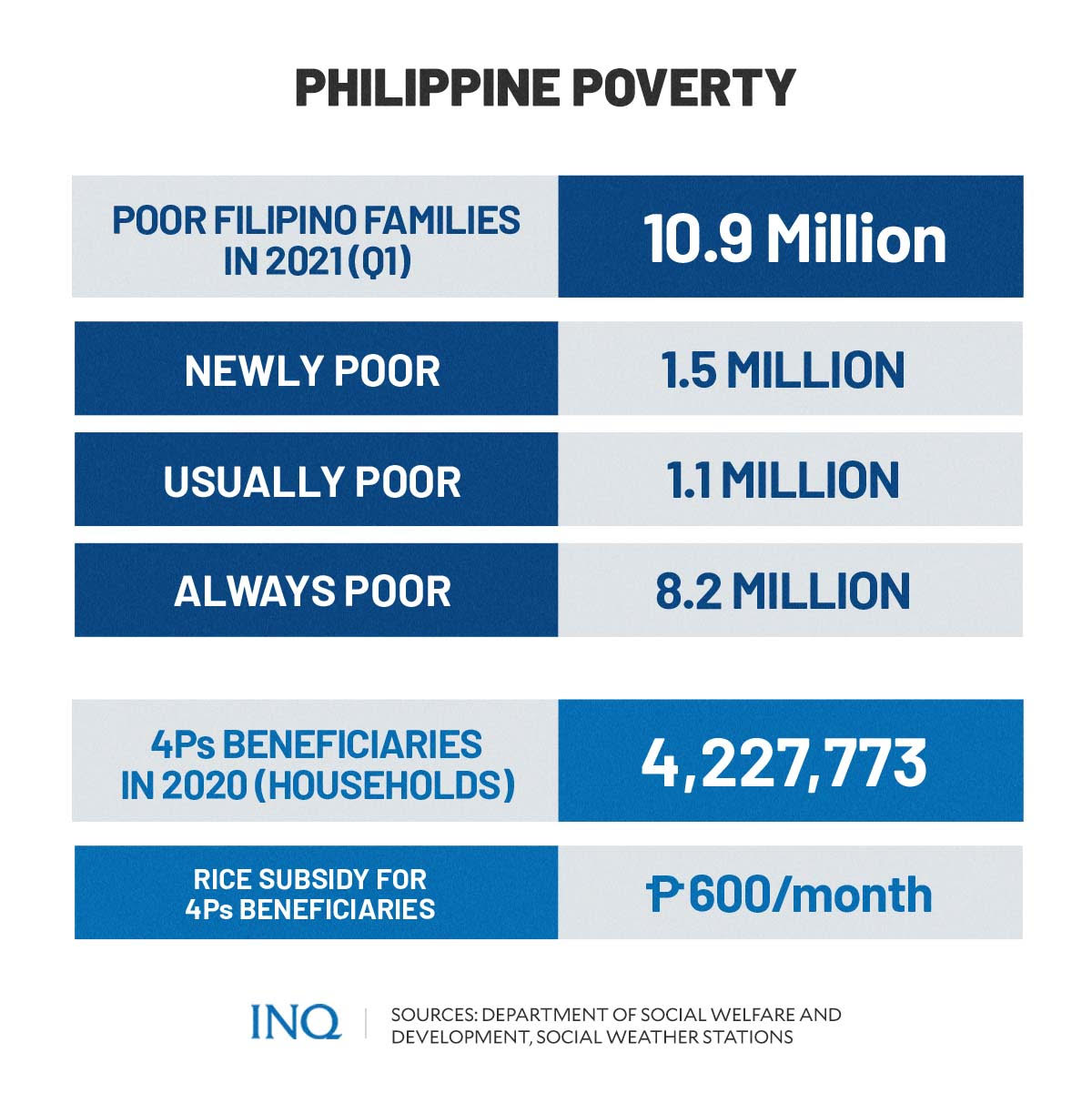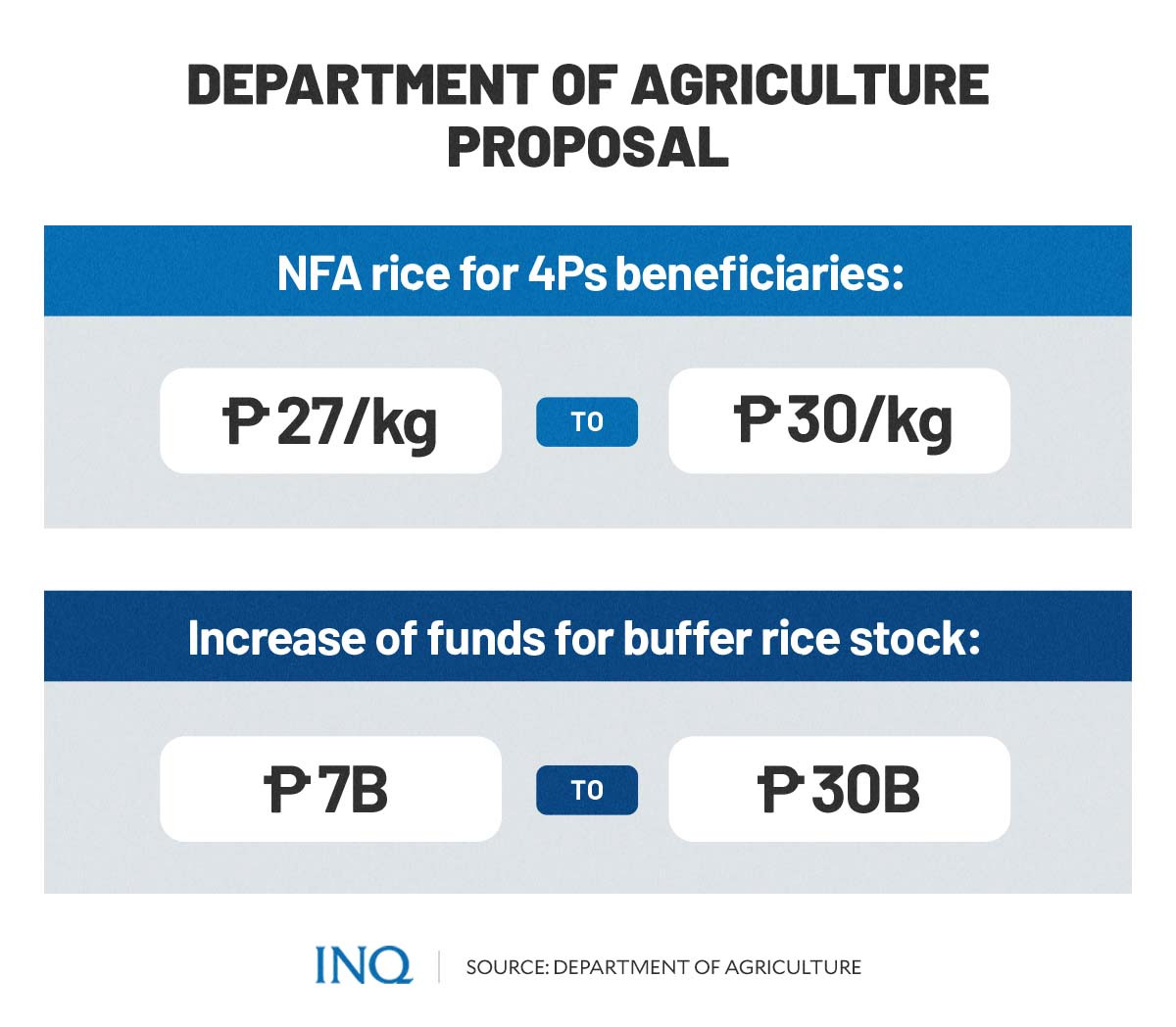Return of NFA rice for the poor eyed, but seen as tariffication failure
MANILA, Philippines—Three years after the supply of subsidized rice in the market came to a standstill, the Department of Agriculture (DA) recommended that National Food Authority (NFA) rice be made available again for beneficiaries of the government’s Pantawid Pamilyang Pilipino Program (4Ps), or the poorest of the poor.
Last week, Agriculture Secretary William Dar declared the department’s plan of “mobilizing” rice retailers to sell NFA rice for P27 to P29 a kilo, saying that should the government extend its stocks, rice bought by the NFA could be rolled over and sold through these retailers.
Dar, however, made it clear in an interview with radio station dzBB that 4Ps beneficiaries would be only “first priority” in access to subsidized rice and this would be available in markets again. “If we already have enough supply, we can add the rest of the indigents,” Dar said.
He said this would depend on funds to be provided by the national government to the NFA. “As we have more budget for the NFA, we can roll over more rice every now and then for the NFA outlets,” said Dar.
If subsidized rice would be made available to the poor, it would require funding enough to bring supply to at least 10.9 million Filipinos, who rated themselves poor, according to results of a recent Social Weather Stations (SWS) survey. The survey said at least 43 percent of respondent families rated themselves poor while 34 percent borderline poor in the first quarter of 2022.
READ: 10.9M Filipino families felt ‘poor’ in Q1 of 2022 – SWS survey
The number of self-rated poor families rose in April from 10.7 million in December 2021. Out of the 10.9 million poor families, 1.5 million were newly poor; 1.1 million were often poor; while 8.2 million said they were “always poor”.
Rice instead of cash
As the Official Gazette stated, through 4Ps, a household with three children may receive P1,400 a month—or a total of P15,000 a year—for five years through cash grants for health and education.
But in 2017, 4Ps beneficiaries who were “active and compliant with the program’s conditionalities” likewise started receiving P600 a month in rice subsidy following the directive of President Rodrigo Duterte in his first State of the Nation Address.
The Department of Social Welfare and Development (DSWD) said that in 2020, 4,227,773 households were served—172,227 less than the 4,400,000 households that were originally targeted for that year.
With Dar’s proposal, Agriculture Assistant Secretary Noel Reyes told INQUIRER.net that instead of the P600 cash, 4Ps beneficiaries will start receiving actual rice. “That is Secretary Dar’s recommendation,” he said.
“With an executive order, the President can direct the DSWD to transfer the resources for rice subsidy of 4Ps beneficiaries to the NFA, which it will use to buy palay from farmers—mill it and then distribute the rice to 4Ps beneficiaries,” he said.
According to the DA’s price monitoring program, Bantay Presyo, last May 20, one kilo of regular milled rice (RMR) and well-milled rice is worth P38 and P40, respectively. This means that the P600 cash given to 4Ps beneficiaries is enough for only 15 kilos of rice.
Reyes said that with the proposal to transfer the budget for rice subsidy to the NFA from the DSWD, the P600 cash could give a household 22 kilos of NFA rice if sold for P27 a kilo.
However, for Sonny Africa, executive director of the think tank Ibon Foundation, the DA should clarify the budget for the subsidized NFA rice. “We can compare it with the budget for the current rice subsidy which is P28.1 billion,” he told INQUIRER.net.
Dar earlier said that supplying P27 to P30 per kilo of rice for the “poorest of the poor” is possible if the budget for rice buffer stock is increased to P30 billion which will translate to a 30-day buffer stock.
Currently, the NFA has P7 billion, which is only good for a seven-day buffer stock. For Dar, the NFA would need P30 billion in resources. “We need 23 billion more so we’ll have P30 billion a year,” he said.
‘RTL failed’
However, for the Federation of Free Farmers (FFF), the proposal to revive the distribution of subsidized rice in the market is a tacit admission that the rice tariffication law (RTL) was unable to significantly bring down prices of rice and make this affordable to the poor.
The RTL, which took effect in 2019, stripped NFA of its price stabilization functions and relegated the office to the maintenance of stocks for distribution when there are disasters and emergencies. It was also allowed to dispose of aging inventories and replenish them with new stocks.
READ: NFA to stop selling cheap rice
FFF said the proposal for the NFA to again intervene in the rice market proves that the “claims regarding the beneficial effects of the RTL were mainly illusory,” stressing that while rice prices did go down from their peak in the 2018 rice crisis, present retail prices for RMR have not changed significantly compared to 2016 and 2017.
“Official data from the Philippine Statistics Authority (PSA) show that prices of RMR in Metro Manila averaged P38.12 a kilo in 2021 which was actually higher than the average prices of P37.46 in 2017 and P37.68 in 2016. Nationwide, retail prices for RMR declined by only P1.40 a kilo on the average between 2017 and 2021,” the group said.
For FFF, the DA proposal “contradicted the spirit, if not the letter, of the RTL,” saying that “the whole theory of RTL was that a free market and open competition without any government intervention would ensure that rice prices would go down to the lowest possible level with the entry of cheap imports”.
“This did not happen,” it said while stressing that retail prices for consumers are still basically the same, “and it was the importers and traders who reaped most of the benefits from the law”.
Raul Montemayor, FFF national manager, said PSA data showed that rice prices in Metro Manila even went up when wholesale prices declined by an average of P2.39 a kilo following the influx of cheap imports.
“The average margin between wholesale and retail prices for RMR increased from P4.40 a kilo prior to RTL to P7.21 a kilo after the law’s passage. In other words, the benefits from cheaper imported rice were captured by importers, wholesalers and retailers, and not passed on to consumers,” he said.
‘It’s making a headway’
Last week, Socioeconomic Planning Secretary Karl Chua said the RTL “is the best model that we have to help both farmers and consumers.
He stressed that by removing quantitative restrictions, “we were able to address both the needs of consumers for a lower retail price of rice and use the tariff revenues to fund the Rice Competitiveness Enhancement Fund (RCEF) and provide even more assistance to farmers with excess tariff revenues”.
Republic Act No. 11203 replaced quantitative restrictions—a ceiling on volume—on imported rice with tariffs of 35 to 40 percent and established the RCEF, which is financed by the tariff revenues.
RELATED STORY: Duterte signs rice tariffication bill into law
The RCEF consists of an annual appropriation of 10 billion pesos in six years to fund programs for farm mechanization, seed development, propagation and promotion, credit assistance and extension services.
RELATED STORY: Imports’ continuing impact on PH farmers: Like dislocating the kneecaps
Chua said these programs were specifically identified to improve the productivity of rice farmers, reduce production costs and link them to the value chain.
“Last year, we collected P18.9 billion from rice tariff collections. We gave all that back to rice farmers. Those calling for the removal of the RTL risk taking away what we are giving to farmers to improve their productivity,” he said.
For Chua, “contrary to the claims of some critics of the reform, the increase in importation did not hurt local rice production. In 2021, palay production increased to 20.0 million metric tons (MMT), 3.5 percent higher compared to 2020. This was in spite of the increase in rice imports in 2021 to 2.9 MMT”.
However, Montemayor said in February that with the stream of rice imports in recent months, there is a potential decline in prices of palay in the dry season.
READ: Rice glut seen with harvest season imports
“When we have a peak harvest by yearend like last year––October, November and December––we really have an excess and then there’s a lot of rice imports, too,” he said.




